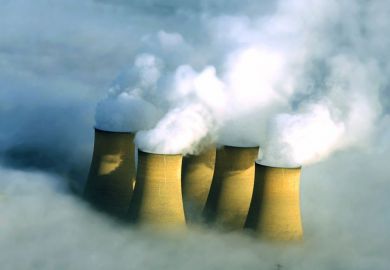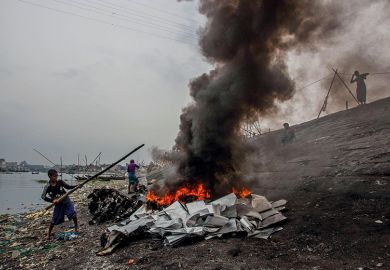Taken separately, the defence of the environment and the rise of artificial intelligence are two of the most fundamental themes for debate in society today. When the two topics are brought together, however, they offer us an opportunity for a radical and potentially world-changing discussion. This book by Keith Skene makes an interesting starting point.
As I began reading it, I was struck by a powerful sense of déjà vu that took me some time to analyse. When its origins became clear, it was both visceral and transporting. Abruptly, I was once again a long-haired 20-year-old buried in the bleak, block-built seminar room of a concrete university, perched awkwardly on an orange plastic chair debating some novel themes of environmental philosophy with a tie-dyed postgraduate. This was the late 1970s, and environmentalism as a movement was still in its early stages: pollution control, recycling, climate change and the limits to natural resources were some of the new touchstones being brought together as part of a common theme. The world has changed greatly since then, and not entirely for the better. But some 40 years on, we have an arsenal of new technologies at our disposal for the monitoring, analysis and modelling of environmental change – far beyond the iconic but flawed first steps of early protagonists such as the Club of Rome.
To call this text wide-ranging would be a significant understatement, and Skene has set himself an enormous task. Across 10 discrete sections, he seeks to define and illustrate not only the nature of human, and non-human, intelligence – but also the diverse nature of ethical debate, the nature of economics and sustainability, the myriad threats that human exploitation poses to the biosphere, how these could be addressed and the dramatic structural changes to society that would be necessary.
The echoes of the 1970s are apparent throughout the establishing sections of the book, with Skene delving deeply into the origins of environmental consciousness and restating the conditions and triggers that led to its becoming mainstream. He moves beyond mere concern for the environment and cites arguments for there being a significant existential threat facing humanity. His list of examples runs from lithium extraction in Bolivia through the collapse of Atlantic cod fishing to the arrival of the Anthropocene itself and, perhaps inevitably, citation stalwarts such as Garrett Hardin and his “Tragedy of the Commons” paper get wheeled in as supporting acts. To this mix are added deeply ingrained cultural images such as scenes from John Steinbeck’s The Grapes of Wrath and its parallels in other areas of soil degradation – further darkening the mood and leaving us in no doubt that we are in real trouble as a species.
Skene takes the same broad-ranging approach to his discussions about the nature of intelligence. A plethora of resources, both expected and unexpected, informs the analysis relating to intelligence in humans. We are treated to a vibrant range of anecdotes regarding figures from Linnaeus to Darwin by way of Mary Shelley, which adds significant colour but occasionally obscures the line of argument. Moving beyond humanity to the (perhaps vexed) question of intelligence as a broader concept, Skene explores the concepts of swarm intelligence and the wisdom of crowds, culminating in an exposition of how “ecosystem intelligence” might be employed as a tool in developing sustainable global solutions to environmental management – through the agency of artificial intelligence (AI) systems.
Having established the background to artificial intelligence as a concept early in the text, Skene pulls no punches when it comes to the potential flaws of such systems. He sets the scene well in his discussion of how AI systems can be intrinsically biased – with or without direct intent – if they are built and trained without adequate safeguards. For example, if an AI is tasked with analysing an image of a human hand holding an object, the system should not classify it as a “tool” or a “weapon” depending on the colour of the person’s skin. Drawing on plot lines from a variety of science fiction dystopias, he leaves us in little doubt as to how poorly we might be served by such systems in the future if we fail to ensure that they reflect the values appropriate to an advanced civilisation.
The message we are left with is that our society must change radically in order to ensure a secure future for the global ecosystem – and that artificial intelligence could be harnessed to help maintain and develop our planet. To fully achieve this would require us to accept a subordinate – “sub-optimized”, as Skene puts it – role in the global pecking order. The core tenet is that no single element of the ecosystem can expect its life and resources to be perfected at the expense of the common good. The huge barriers to global acceptance of this proposal, not to mention the equally massive problems of how to transition to such a model and how the resulting system could be managed, could each occupy a significant tome in their own right, but Skene makes a valiant – and largely successful – attempt to draw out some of the major threads.
Artificial Intelligence and the Environmental Crisis has a huge canvas, and, perhaps inevitably, this occasionally results in some arguments that appear slightly stilted. In addition, the term “artificial intelligence” is sometimes used in a wide-ranging rather than closely targeted sense, encompassing a broad range of technologies. While this allows Skene to propose globally impactful directions without being constrained by current approaches, those looking for a tightly practical focus on tools and techniques may feel unsatisfied.
Theoretical analysis of the core topics is interspersed with vivid illustrations of how these can impact on the human environment. It is in these descriptions that Skene’s prose really comes to life and where, I suspect, he is happiest as a writer. Although the text discusses the global degradation of Earth’s biosphere, it is in the detailed observations of his immediate environment and direct experience – such as the unconcerned destruction of a swallow’s nest by a neighbour – that his writing feels most effective.
This book is a passionate manifesto, a call to arms, by someone who clearly cares deeply about his subject. The tragedy is that it needed to be written, more than 40 years after the nature of climate change and environmental degradation was already being taught as a mainstream topic to UK undergraduates. To see the arguments having to be re-presented, and extended both in scope and urgency, demonstrates how little substantive progress we have made towards an effective solution.
John Gilbey teaches in the department of computer science at Aberystwyth University.
Artificial Intelligence and the Environmental Crisis: Can Technology Really Save the World?
By Keith R. Skene
Routledge, 276pp, £133.00 and £45.00
ISBN 9780367152000 and 9780367436544
Published 19 December 2019
The author
Keith Skene, director of the Biosphere Research Institute, was born in Armagh, Northern Ireland and studied life sciences at the University of Dundee. However, a year of his degree spent at the University of Illinois, Urbana Champaign, he recalls, made him realise that “Dundee was emerging from a post-industrial apocalypse, as the jute mills, marmalade factories and watchmaking industry evaporated, leaving huge unemployment and a loss of identity as a former powerhouse. I used to busk in the city centre to earn some extra money, writing reflective ballads on the plight of the town.”
Committed to social as well as environmental sustainability, Skene has been both a foster carer and a community youth worker as well as an academic. Although he enjoys teaching and continues to lecture at a number of universities, he decided to give up his full-time position at Dundee in 2010 and set up his own institute in order to “work on some of the big problems facing us”.
He was led to this, he says, because of “a growing frustration with the silo mentality” and a system of research assessment that was “very limiting in terms of not rewarding transdisciplinary blue-sky research…Bringing in grants in excess of £1 million was expected. Then top grant earners were removed from teaching to optimise income, while the rest of us were forced to only teach.”
So what does Skene see as the role of wide-ranging philosophical reflection, alongside concrete practical initiatives, in addressing the challenge of climate change?
“Social, environmental and economic sustainability are completely intertwined and multifaceted,” he replies. “Climate destabilisation is just a symptom. We need a deep, holistic and wide-ranging approach, where trade-offs are positive, not negative, signifying a working system, and where we all talk to each other about all of it. Reductionist, linear thinking will not suffice here, and has led us to this crossroad.”
Matthew Reisz
POSTSCRIPT:
Print headline: Tools of salvation or destruction?
Register to continue
Why register?
- Registration is free and only takes a moment
- Once registered, you can read 3 articles a month
- Sign up for our newsletter
Subscribe
Or subscribe for unlimited access to:
- Unlimited access to news, views, insights & reviews
- Digital editions
- Digital access to THE’s university and college rankings analysis
Already registered or a current subscriber?








